Toe contractures are painful conditions that often occur alongside other foot conditions, such as corns and warts. One type of toe contracture is a mallet toe, which affects the joint nearest to the end of your toe. Hammertoe, on the other hand, is a toe contracture affecting the middle joint of the toe. Hammertoe is the most common of these conditions. This article will discuss the diagnosis and treatment of toe contractures and common comorbidities.
Definition and Classification of Toe Contractures
A toe contracture is a malformation of the joint caused by the flexor muscles (the muscles that bend the toe) overpowering the extensor muscles (the muscles that extend the toe).
There are several classifications of toe contractures based on location:
- hammertoe – proximal joint
- mallet toe – distal joint
- claw toe – both joints
For clarity, we will focus specifically on hammertoe in this article.
What Is a Hammertoe?
Best Podiatrist in Brooklyn Answers
A hammertoe is an abnormal contracture in the toe located at the joint nearest to the ball of the foot. This joint is approximately in the middle of the toe and gives the appearance of the toe being bent in half. Hammertoe and mallet toe typically only develop in the middle toes, not the great toe or pinky toe.
A Note about Foot Anatomy
Each of your toes has three joints: one where the toe meets the foot, one in the middle, and one closer to the end of the toe. A contracture at the most distal joint is known as a mallet toe. A contracture at the middle joint is a hammertoe. If both joints are deformed, it is referred to as a claw toe.
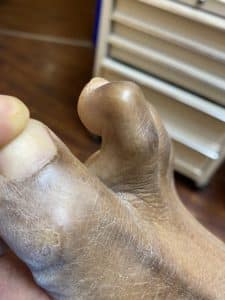
What Are Common Symptoms of Hammertoe?
Hammertoe can be quite painful and negatively impact your gait. They can significantly impair your daily activities. For this reason, many patients seek medical care quickly for pain relief. In addition to pain, other symptoms include:
- Corns
- Calluses
- Difficulty walking
- Decreased quality of life
- Inability to participate in normal day-to-day activities
Hammertoe affects the way your shoes fit. It often causes your shoes to rub on your toes in unintended ways. This can cause pain, blistering, and difficulty walking. Since hammertoe affects the way your feet look, it can also lead to embarrassment or reluctance to show your feet in public.

Non-medical results of hammertoe may include feelings of frustration, uncertainty, and depression related to health stress; financial struggles related to medical bills, therapy, medications, and custom footwear. Medical relief often comes with a cost, be that emotional or financial. Therefore, being aware of this aspect of your health and seeking support and care in all aspects of your life is vital. Surround yourself with people who can help in whatever area you need.
What Causes Hammertoe?
We now turn our attention to what causes hammertoe. There are several different categories of factors.
Anatomical/Genetic Causes of Hammertoe
- being flat-footed
- a very high arch in your foot
- genetically long toes
Lifestyle Causes of Hammertoe
- wearing high-heeled shoes
- wearing shoes that are too tight or narrow
Medical Causes of Hammertoe
- arthritis
- genetically long toes
- having second toes that are longer than your big toes
- presence of Hallux valgus/bunion – when the big toe pushes all other toes up
- trauma, including fractures, crushing injuries, and joint compression
- suffering from diabetes mellitus
Hammertoe Pathophysiology
The classic sign of a hammertoe is curling or bending at the middle joint. This occurs as the toe is forced to hold an abnormal position, and the muscles and tendons begin to stretch and are unable to relax. This leads to a tight bend in the joint and an inability to straighten it. Since the toe is turned abnormally downward, its shape looks somewhat like a hammer. Hammertoe typically does not improve on its own; instead, the pain and deformity continue to worsen if not treated.
Usually, only one or two toes are involved. The second toe (next to the big toe) is the most common culprit, followed by the third and fourth toes on each foot.
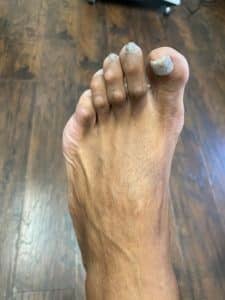
Relationship of Cause and Treatment of Hammertoe
A Podiatrist From Brooklyn Explains
Knowing and understanding what caused your hammertoe is key to treating it. If you suspect that your shoes are contributing to the pain, stop wearing them immediately and find a pair that is supportive and comfortable. Custom shoe inserts can also help support your foot and hammertoe, even beginning the process of reversing the damage that has been caused by poorly fitting shoes.
Some patients are reluctant to give up their favorite shoe styles or brands. High heels are associated with glamor and elegance, and narrow, tight dress shoes are often expected in formal situations. However, the cost of wearing uncomfortable shoes is not worth the benefit.
Hammertoe Comorbidities
We will discuss more hammertoe treatments later in this article, but for now, let’s turn our attention to common comorbidities of hammertoe. A comorbidity is a condition caused by or otherwise connected to the original problem (in this case, hammertoe) and requires personal or medical attention, taking your focus away from the main problem.
Comorbidities are real and must be treated appropriately, but they can easily become the focus, while the original condition takes a back seat. In this case, the original condition continues to worsen, increasing the risk for more or worsening comorbidities. It is a vicious cycle, an uphill battle, and patients and providers alike must be vigilant to keep in mind the cause of the comorbidities as they treat them. Finding and treating the root cause is always the most effective way to see relief from all comorbidities.
Comorbidity: Corns
One of the most common comorbidities of hammertoe is corns. Patients usually present with a hard corn, which causes pain and swelling on top of the affected toe. Corns are thickened areas of a dead layer of the skin (the corneal layer of epidermis) and are usually located on the top of the toe or on the bottom of the foot. The corns are usually located on the top of a bone spur at the contracted joint. They present as a single, rounded area of hardened skin.
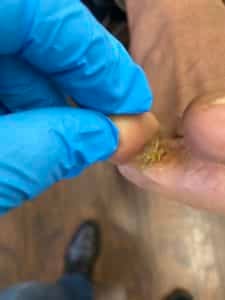
Bony prominences like bone spurs cause extra pressure on the skin, which leads to the creation of extra protective layers. If this extra skin has a centralized core deep enough to press a nearby sensory nerve, the patient will experience a painful corn. Though uncommon, corns can develop on the bottom of the foot. They are usually located under enlarged metatarsal heads (bone spurs). This happens due to uneven pressure distribution, with most of the pressure being localized on the bone spur. Most commonly corns develop on the pinky toe (5th digit) because it is closest to the shoe, or on the second toe since it is the longest toe.
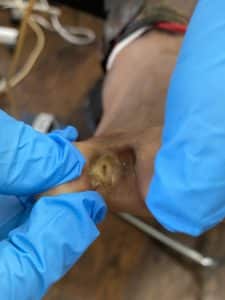
Seed Corns
Some corns are caused by clogged sweat glands. These groups of tiny corns are known as seed corns. They are usually found in clusters at an area that receives consistent pressure or friction from a shoe that is too tight. Seed corns require careful monitoring, but treatment is simple: Keep your feet clean and dry, watch for signs of infection, and apply over-the-counter corn medication.
Corns Vs. Calluses
Corns are a common yet painful condition that should be taken seriously. Corns are usually painful with a centralized core. They do not bleed when removed because they do not have a vascular supply. Corns are differentiated from calluses due to their size and location. Most corns are smaller and occur near bony prominences such as bone spurs.
In contrast, calluses are wide and flat and are usually found on the bottom of the foot. Calluses are not consistently painful, though they may become inflamed or sensitive. Calluses are considered normal, and they don’t require treatment if they’re not causing a problem. Some people don’t like the way their calluses look, but unless they’re causing pain, you can leave them alone without worries.
Corns that are very tiny, otherwise known as seed corns, can be more difficult to identify. They can easily blend into their surroundings if they are on or near a large callus. Seed corns are often groups of many tiny corns clustered together. If left untreated, they can become infected and grow more painful over time.
Corns vs. Fungus | Best Podiatrist in Brooklyn and NYC Distinguishes
Painful corns on the inside of the toe are commonly mistaken for a fungus. It may look like a fungus, but fungus in between the toes never hurts. If you experience pain when applying pressure to the area it is a corn. Remember, corns occur because of the enlargement (hypertrophy) of the head of the toe rubbing against the next toe. Usually, a soft corn happens on the inside of the 4th or 5th toes.
The most common fungus to affect the area between your toes is athlete’s foot, or tinea pedis. This causes itching and scaly skin between your toes, but treatment will be much different from that for corns. It can cause burning pain, too, as well as an inflamed, red area. However, treatment for corns won’t help with athlete’s foot. You’ll often need antifungal medication to eliminate the infection.
What Are the Risks of Not Treating Corns?
If left untreated, the corns can lead to increasing pain and suffering, ulcers, infection, difficulty walking, difficulty wearing dress shoes, and can even require an amputation (usually in patients suffering from diabetes).
Comorbidity: Corns vs. Warts
If you have a painful area on the bottom of your foot, it could be a corn (made out of a dead layer of the skin, usually on an area of extra pressure), a wart (a skin virus that lives on the superficial layer of the skin), a cystic mass, or a foreign body.
To diagnose and treat each of these conditions, we use different techniques.
As we have already discussed, corns are hyperkeratotic lesions made up of concentrated layers of dead skin that usually occur in an area of extra pressure because of an underlying bone spur. The most common reason for bone spurs is an enlarged head of a metatarsal that can be seen on an X-ray as extra bone growth. This excess growth causes increased pressure on that area of the foot.
Sometimes redness, swelling, and pain indicate a plantar wart rather than a corn. This lesion on the bottom of the foot can easily be misdiagnosed as a corn until it is treated. If warts cause pain, it’s usually because of pressure or friction while walking. At rest, they are rarely painful. Warts incur pinpoint bleeding upon debridement, while corns don’t bleed. Also, warts often present in the form of clusters or a mosaic pattern rather than singular lesions. Remember that warts are typically rough to the touch, and they often feature clusters of tiny black dots.
It’s important to note that warts and corns have completely different causes. Warts are caused by a virus, while corns are caused by friction, pressure, or rubbing. Thus, you will never be able to treat a wart by changing the shoes you wear or choosing to wear socks. You can often shave down the wart with a pumice stone to reduce its size. For a permanent solution, freezing, salicylic acids, or other treatments are often necessary to counter the virus causing your wart.
Treatment for Painful Corns
You can treat a corn at home with a few simple remedies. For one thing, you can purchase specially designed patches over the counter. These can help to relieve pressure and friction from your corn. Also, be sure your toenails are properly trimmed. Nails that are too long can make your shoes rub on your corn.
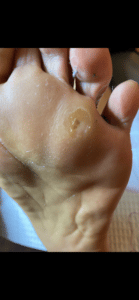
Also, try soaking your foot in warm water to soften the skin and surrounding areas. Add some soap, but make sure to use a gentle option. Gently use a pumice stone to file down through the layers of the corn. If it starts to bleed, stop and keep the area clean and dry. Apply a non-scented, gentle lotion to your feet, but only on intact skin. Do not put any lotion on the corn if it has been bleeding.
Watch the area carefully for infection. Signs of infection include:
- Redness
- Swelling
- Warmth
- Increasing pain
- Fever
- Nausea
If you experience any signs of infection, contact your NYC podiatrist immediately.
If you do use corn patches, proceed with caution. Using corn patches to remove the painful corn will only help temporarily, and the patches can create breaks in the skin, leading to infection. In addition, the corn patches can not eliminate the cause of the pain: the bone spur.
Warning about Home Treatments for Corns
When considering home remedies for treating corns, there are four things to avoid:
1) Do not use blades to remove them because they may cause lacerations and infection.
2) Do not use corn patches because you cannot control the depth of penetration of the chemicals used to destroy the corn. The main chemical (lactic or salicylic acids) will destroy surrounding healthy skin, creating open wounds on your foot.
3) Avoid using treatments designed for other foot conditions, such as plantar warts or fungus. These won’t effectively treat your corn and could cause complications.
4) If you are a diabetic patient, avoid any attempt to treat corns on your own at home. Diabetic foot care is best left to professionals.
Treating the Cause of a Corn
It is always more effective to treat the internal or external cause of the corn rather than just the structure itself. By treating and eliminating the cause, you guarantee that the corn will not return for the same reason time and time again. Treating the cause of a corn is a relatively simple procedure.
Painful corns between the toes can often be easily eliminated by removing the bone spur, a simple 4-minute procedure known as an exostectomy. This minimally invasive surgery finishes with 1 or 2 stitches and a small dressing. It is performed in an outpatient setting and is typically safe and effective. Patients can walk right away and will return to wearing regular shoes the next day. The healing process is easy and fast, usually 7-10 days in a light bandage.
Brooklyn Podiatrist and Treatment: Corns vs. Warts
Treatments for corns and warts are different. When a painful corn is formed as a result of an underlying bone spur, custom-made orthotics with a dispersion on the corn area can be helpful. But very often, the painful corn requires a surgical correction (bone spur removal) to shave off extra bone growth and eliminate the pressure that caused the corn. The procedure usually takes 15 minutes with 2-3 stitches. Patients can walk right away and return to wearing regular shoes in 2 weeks. After such a surgery, the pain should be eliminated immediately.
Warts are not usually painful, which can help you differentiate them from corns. If left untreated, they often go away by themselves after a couple of years. However, in the meantime, they can be embarrassing, uncomfortable, and unsightly.
In cases where the lesion on the bottom of the foot is a wart, home remedies might be worth a try at first. Treatments like duct tape or foot soaks might have some success. You can apply salicylic acid in liquid form or apply patches soaked with this medication. This acid causes skin to peel off, which can remove layers of skin affected by the virus. You can also use a pumice stone to physically remove some of the outer layers of your wart. When doing home treatments, be very careful not to spread the wart to the surrounding skin. Also, be careful around others in your household. While corns are not contagious, warts can spread to people around you.
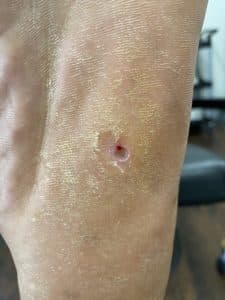
However, when home remedies fail, clinical help becomes necessary. Medical treatment may include debridement with silver nitrate application, bleomycin injections, liquid nitrogen, or wart patch application. These approaches typically require multiple treatments or are ineffective.
However, at Best Foot Doctor NY, we offer a one-time, 100 percent guaranteed procedure for the total excision of the warts. This provides total removal of all possible clusters using a surgical blade and possibly suturing small areas of skin. With an excision procedure, the warts are eradicated with only one visit. Scarring may occur, but it is usually much less unsightly than a persistent wart on your foot! You may have some itching and soreness after the procedure, but it’s important to avoid touching the area while it heals.
Immediate Home Remedies You Can Begin Today for Hammertoe
We will now return to hammertoe and specifically how to fix hammertoe. After considering the common comorbidities and how to treat them, use the following information to familiarize yourself with treatment for hammertoe.
If you are experiencing pain or notice any structural deformity around the middle joint in your toe, schedule an appointment with your local New York podiatrist immediately. There are both surgical and nonsurgical options for treating hammertoe, and your doctor can help you decide what’s right for you. They can help you determine what caused your hammertoe and work with you to begin the right treatment and help prevent further discomfort. However, while you are waiting for an appointment, you may be wondering if there is anything you can do at home to get some relief. And there is! Home treatments can provide symptomatic relief and temporarily slow the progression of your condition. However, home remedies should not be considered an alternative to a visit to the podiatrist. Seek professional medical attention as soon as possible.
Consider Your Shoes
Often, the source of pain can be traced back to wearing ill-fitting or damaging footwear. Remember, we said that hammertoe can be caused by wearing high-heeled shoes or shoes that are too tight? Over time, excessive pressure on your foot and toes weakens the ligaments and muscles holding the joint in place. Once an injury happens, the shoes continue to perpetuate the problem.
Make sure that your shoes fit you well without being too snug, especially in the toe area. High heels are often a source of pain and pressure on the joints of the foot. Whenever possible, choose shoes that have good arch support and a small, boxy heel. There are many beautiful, formal shoe options without a dangerously high heel that may be a better option for you at this time.
If you do need to wear shoes that don’t fit well or have a high heel, be creative. Consider bringing a second pair of shoes to your event that you can change into. Look into custom orthotics that will enhance foot support as you wear different pairs of shoes. Try to wear uncomfortable shoes for only a short time, and change into other options as soon as you’re able.
How to Choose Shoes that Fit Well
Living in NYC? Take advice from Brooklyn’s Best Podiatrist
When you are shopping for shoes, it is best to try them on at the end of the day when your feet are slightly swollen from the day. Make sure that you can wiggle your toes and that there is sufficient support around the arch and ankle area. Shoes that can be adjusted with a strap or shoelace have the best chance of fitting your foot well.
Try Home Pain Relief Options
Other options to try at home include ice packs to decrease swelling and inflammation from your hammertoe. You can also purchase special hammertoe pads that are designed to take pressure off the affected area when you walk. While these may not cure your hammertoe, they can provide some much-needed relief to help you get through the day.
How Does Best Foot Doctor NY Treat Hammertoe Without Surgery? | Brooklyn NYC
When you arrive for an appointment, you can expect the podiatrist to ask you questions about your symptoms and health history. They will complete a partial physical exam and may take X-rays to better understand how the ligaments and muscles are functioning. After a thorough assessment, your doctor will discuss how to fix your hammertoe. In some cases, hammertoe surgery is recommended, but our podiatrists at Best Foot Doctor NY will always consider non-surgical options first.
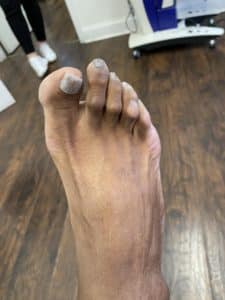
Physical Therapy Exercises to Strengthen Your Toes | Brooklyn Podiatrist’s Recommendations
Physical therapy exercises can help to strengthen the muscles and ligaments in your toes and adjust the joints properly. Consult your doctor before beginning any exercises to ensure that they will not further injure your toe. Hammertoe therapy usually includes the patient wrinkling fabric or picking up small objects with their toes. The podiatrist or physical therapist will give instructions as to how many repetitions to perform and what to watch for as you complete the exercises.
Custom Orthotic Inserts to Realign Your Hammertoe
In addition to physical therapy, you may be able to treat your hammertoe with external support such as splints and inserts.
Splints gently hold your toe in place to direct and strengthen the muscles and tendons. Over time, the joint will regain an appropriate alignment, and you will notice a decrease in pain and stiffness.
Custom orthotic inserts work by supporting the sole of your foot in a neutral position. While many drug stores in New York City carry shoe inserts, it is best to make an appointment with your podiatrist so that they can make a mold of your foot and create an insert that is custom-fit for you. Orthotic inserts can cause increasing joint pain if they are not properly fitted for your foot.
If these home and non-surgical options are not providing relief, communicate with your doctor right away. In some cases, the muscles and tendons are too tight to realign on their own, or the joint itself has become deformed and will not heal without surgery. Hammertoe surgery also treats bone spurs, corns, and other comorbidities that may have developed.
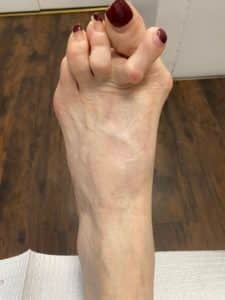
Hammertoe Surgery NYC
Now that we have discussed the definition and causes of hammertoe, symptoms, common comorbidities, and conservative treatments, we will turn our attention to hammertoe surgery options in NYC. You should always exhaust nonsurgical options first. However, when home treatments and lifestyle adjustments fail, surgery may be the best option to treat your pain.
Arthroplasty
The procedure to fix a hammertoe is called arthroplasty. This procedure involves shaving down the head of the phalanx (bone spur) to straighten the toe. The surgery will also eliminate the painful corn caused by the pressure between the shoe and the bone spur inside.
The procedure takes about 5 minutes. The surgeon will cut ligaments, tendons, and the ends of your bone as needed to relieve your pain. The wound is closed using 2-3 stitches and followed by an application of bandages. Patients can shower right after the surgery, wearing a shower foot bag. They are also instructed to wear surgical shoes for 10-14 days. Patients can easily walk immediately following the surgery and return to work at any time. Sutures are removed 2 weeks post-surgery. At Best Foot Doctor NY, we do the procedure through a very small incision and use class 4 laser treatment during the procedure. This provides faster healing without visible surgical marks, scars, or swelling.
Financial Considerations
Patients should consider the financial resources available to them, especially for specialty surgeries such as hammertoe surgery in NYC. You deserve to walk comfortably and live life to the fullest. Best Foot Doctor NY accepts all major insurance companies and many smaller companies as well. If you have any questions about financial assistance available to you, call our office, and one of our friendly office staff members will be happy to assist you.
Treatment at Best Foot Doctor NY | Brooklyn NYC
Depending on the cause of the hammertoe, treatment can include correcting the hammertoe, removing the bone spur, or removing the warts or corns. Best Foot Doctor NY uses a minimally invasive approach to safely and easily provide all of these treatments. With offices conveniently located in Brooklyn, Queens, Manhattan, and Rosedale (Long Island), we are ready to help you become pain-free. Contact us today!
